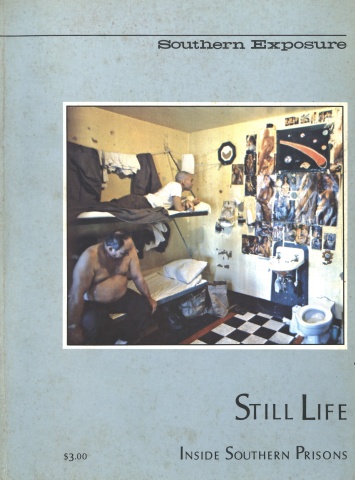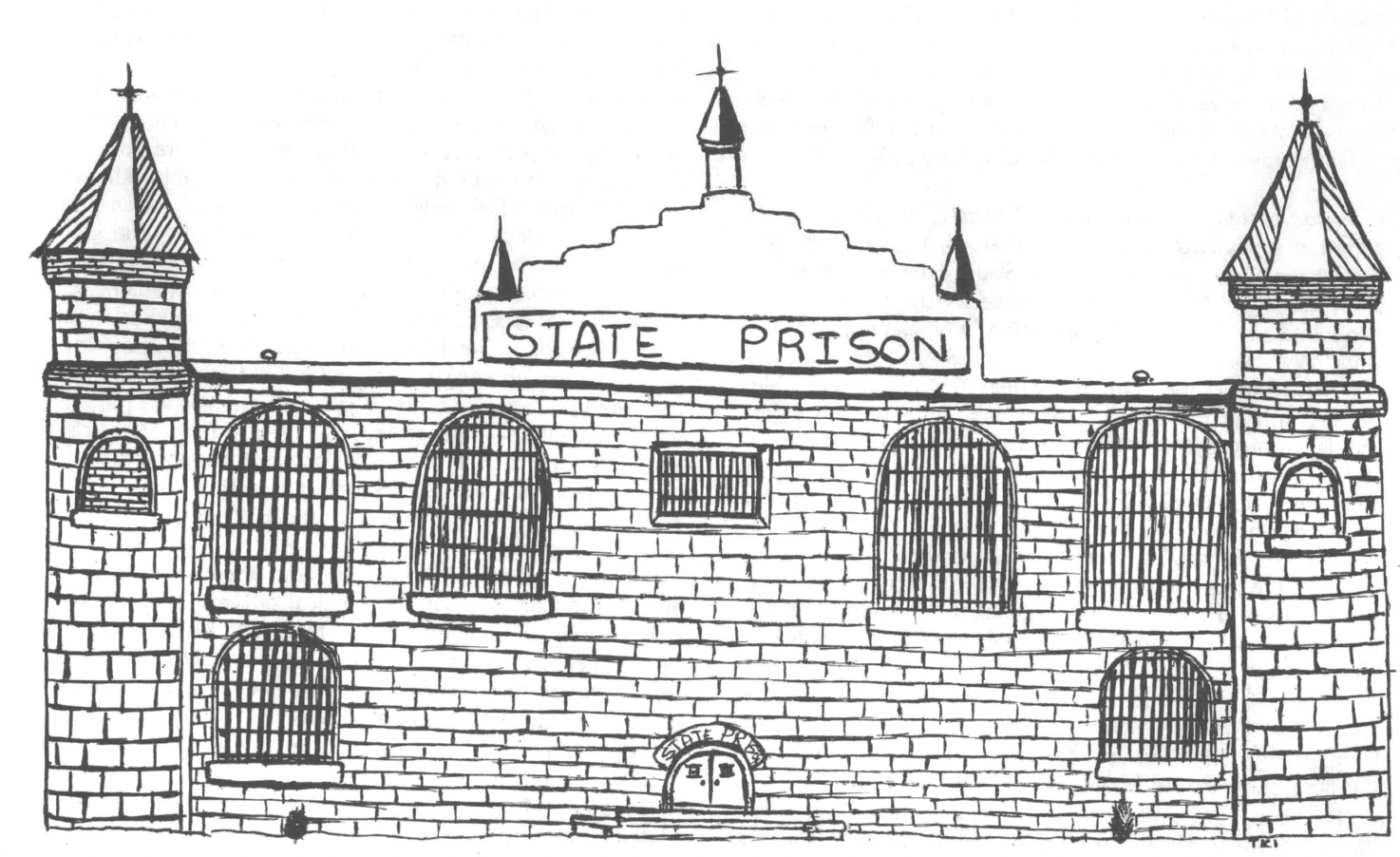
This article originally appeared in Southern Exposure Vol. 6 No. 4, "Still Life: Inside Southern Prisons." Find more from that issue here.
Southern Exposure here assembles from a wide variety of sources statistics on the prison systems in the South. The numbers echo the conclusions of the more personal testimonies elsewhere in this volume: our prisons discriminate against the minorities and the poor, confine people in overcrowded and ill-equipped prisons, do not educate or rehabilitate the incarcerated. Despite that depressing reality, these figures show that the South — more than any other region — continues to expand its already immense prison systems, not because there are more crimes committed in this region, but because imprisonment has become an easy and acceptable method of coping with people the state finds undesirable: the poor, the black, the uneducated, the unskilled. In almost every measure of how well we deal with prisoners, the South lags significantly behind the rest of the nation.
• Southern states incarcerate a far greater proportion of their citizens. The four states with the highest proportion of their population behind bars are in the South. With 28% of the US population, the South incarcerates 38% of the country’s total prisoner population. The incarceration rate — the number of people behind bars per 100,000 people in a given geographic area — is 35% higher in the South than in the country as a whole. In North Carolina, the rate is almost twice that for the nation (chart 1).
Rather than alleviate the social and economic conditions that produce most crimes or embark on meaningful programs to prevent recidivism, Southern states are engaged in massive construction programs intended to increase the capacity of the region’s prisons by 35% by 1982, at an estimated cost of a half billion dollars. Again, the South, with 28% of the nation’s population, will build half of the country’s new prison space. Louisiana, with plans to nearly double its prison capacity, leads the way, but South Carolina, Alabama and Mississippi are close behind with plans to increase their systems by 87%, 73% and 72% respectively. Only two states have no significant growth plans, Kentucky and West Virginia (chart 2). Southern states cannot justify their high rates of imprisonment by high crime rates since figures show little difference from the nation’s norm (chart 3).
• Prison systems in the South are racist. While this repeats common knowledge and court decisions, the numbers still overwhelm. In every state in the South, the percentage of prisoners who are non-white far exceeds the proportion of non-whites in the general population. For example, in Virginia, 19% of the state’s population and 61% of the prisoners are black. In every state for which figures are available, the percentage of blacks in prison is at least twice the percentage of blacks in the state as a whole (chart 4). Conditions for these prisoners are worsened by the low percentage of minority prison employees relative to the prison population. While the prisons typically contain about 50% to 60% blacks, black corrections officers comprise approximately 10% to 40% of the total (chart 4). On the other hand, because corrections work is a low-pay, low-skill, low-status field — and one “serving” mostly minorities — this percentage of minority employees is high relative to the outside population. Moreover, corrections officers in the South receive lower pay than elsewhere: starting salary in 1976 ranged from $6,348 in Louisiana to a high of $8,016 in North Carolina, compared to an average of $8,832 nationwide.
The most dramatic inequities appear in the sentences handed down to blacks. This inequity reflects the bias in our judicial system against not only black people, but against all the poor: those who can’t afford a good lawyer get longer sentences. In each case, the number of blacks and whites serving short terms are almost equal; in each case, the number of blacks serving long sentences is two to three times the number of whites serving comparable sentences. For example, in Georgia 901 whites and 1,183 blacks are serving sentences of one to three years; 523 whites are serving over 30 years compared to 1,067 blacks (chart 5).
• Prisoners are unskilled and uneducated. Although there are few specific figures on the economic backgrounds of prisoners, indirect data shows that almost all are poor; the men and women behind bars have few marketable skills and little education. Few have finished high school; when given tests, most reflect a level of education barely beyond grade school. In Louisiana, the average education by testing is equivalent to completing the fourth grade. In Alabama, the prisoners are classified according to their previous occupations: out of 50 possible occupations, 57% fell into a single one — laborer (chart 6). Critics and corrections officials agree that the key to staying out of jail is having a good job; getting a job requires education. Yet 11 Southern states rank among the worst 13 in the US for per capita expenditures for public education and all 13 spend less than the national average. Every single Southern state has a higher illiteracy rate than the national average.
Prisoners are not only unskilled and uneducated; they are also young (chart 7). This is a logical outgrowth of the phenomenally high unemployment rates in this country for young people, rates which lead directly to widespread dissatisfaction and crime. Education and skills can lead not only to employment, but also to staying out of jail: the money to hire a lawyer. Elsewhere in this volume, Southern Exposure shows how people who receive a death sentence rarely could afford to hire a lawyer and were instead represented by a court-appointed attorney.
• Regardless of race, age or wealth, prisoners in the South suffer far worse conditions than prisoners elsewhere. This contention is supported not only by personal accounts and numerous court cases, but also by figures showing that Southern states spend less money per convict, hire fewer employees per convict and provide few educational or rehabilitative programs (charts 8 and 9). Southern states spend an average of $3,916 per convict each year compared to expenditures of $5,919 nationwide. In 1976, Southern prison systems employed .40 people per convict compared to .46 nationwide; this was a significant improvement for the South over the previous year’s figures of .32 in the South and .45 nationwide. Chart 4 showed how little Southern states pay their corrections employees, suggesting a lack of interest in attracting the most qualified workers. Only at the top, at the level of the director of a board of corrections, do Southern salaries compare to those in the rest of the nation. Rehabilitation programs are virtually nonexistent throughout the South. In Tennessee, only 2% of the corrections budget is allotted to “rehabilitative services.” In Texas, about the same amount of money is allotted for work release programs — which can lead directly to employment for a convict completing a prison sentence — as is paid to the Department of Corrections director. With the lack of rehabilitation programs and the continuation of social conditions which create criminals, high recidivism rates are only to be expected (chart 10).
The worst conditions in Southern prisons arise due to overcrowding. System-wide lawsuits attacking poor conditions - primarily overcrowding, but also including poor health conditions and the lack of functioning classification systems to separate, for example, violent from nonviolent prisoners - have been won in Alabama, Florida, Louisiana, Mississippi and Tennessee. The response of the states to these suits has been cynical at best: when ordered not to admit any more prisoners into already impossibly overcrowded prisons, several states have simply housed their new prisoners in county jails; county jails are notorious for having conditions even more brutal than the state-run facilities (chart 11). Seven Southern prison systems contain more prisoners than they were built to hold; South Carolina is the worst with 50% more prisoners in its facilities than they were designed to hold. Five more states have prisons very close to full. Only one, West Virginia, is not in danger of being overcrowded. Overcrowding has been the primary excuse for the building programs undertaken, but far more humane, rational and inexpensive solutions exist: lower rates of incarceration; more use of rehabilitative programs — especially work release — to decrease recidivism; and prevention of the very conditions that cause crime in the first place.
Tags
Marc Miller
Marc Miller was a staff member of the Institute for Southern Studies and Southern Exposure for eight years. He is now a senior editor of Technology Review magazine. (1986)
Marc Miller is associate editor of Southern Exposure. He edited Working Lives: The Southern Exposure History of Labor in the South, published by Pantheon Books in 1981. (1980)
Marc Miller is an historian on the staff of the Institute for Southern Studies. He is currently editing a book of first person accounts of work in the twentieth century. (1978)

